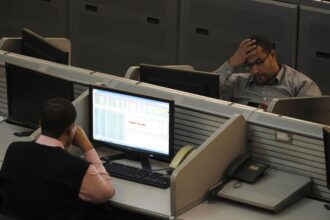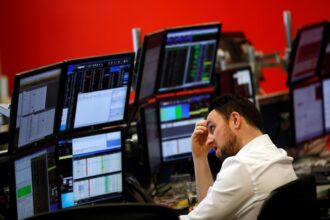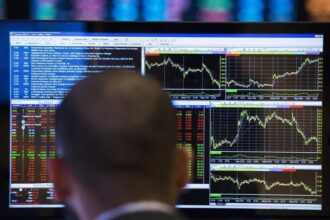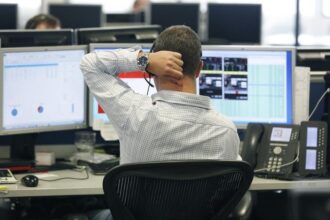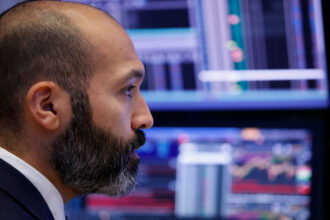© Reuters. FILE PHOTO: Traders work on the floor of the New York Stock Exchange (NYSE) in New York City, U.S., March 30, 2023. REUTERS/Brendan McDermid
By Noel Randewich and Ankika Biswas
(Reuters) – Wall Street closed lower on Tuesday after evidence of a cooling economy exacerbated worries that the Federal Reserve’s campaign to rein in decades-high inflation may cause a deep downturn.
All three major indexes fell as data showed U.S. job openings in February dropped to the lowest level in nearly two years, suggesting that the labor market was cooling, while factory orders fell for a second straight month.
Data on Monday had also pointed to weakening U.S. manufacturing activity.
“The number of job openings has decreased, which makes people worry that hiring is going too slow, and that will be bad for the economy. That feeds into recessionary fears,” said Sal Bruno, Chief Investment Officer at IndexIQ in New York.
Bank stocks took a hit after JPMorgan Chase & Co (NYSE:) CEO Jaime Dimon warned in a letter to shareholders that the U.S. banking crisis is ongoing and that its impact will be felt for years.
Bank of America (NYSE:) and Wells Fargo (NYSE:) & Co dropped more than 2%, and the banks index fell 1.9%.
Of the 11 S&P 500 sector indexes, seven declined, led lower by industrials, down 2.25%, followed by a 1.72% loss in energy.
The S&P 500 declined 0.58% to end the session at 4,100.68 points, closing lower for the first time in a week.
The Nasdaq declined 0.52% to 12,126.33 points, while the declined 0.59% to 33,403.04 points.
Caterpillar Inc (NYSE:), viewed as bellwether for the industrial sector, fell 5.4%.
Heavyweight chipmaker Nvidia (NASDAQ:) lost 1.8%, weighing more than any other stock on the S&P 500’s decline.
Healthcare and utilities, which many investors expect to hold up better during an economic slowdown, were among the few S&P 500 sector indexes gaining on Tuesday.
GRAPHIC: Odds point to no May rate hike https://www.reuters.com/graphics/USA-RATES/FEDWATCH/zdpxdayyrpx/chart.png
Trading in interest rate futures shows bets are now tilted toward a pause by the Fed in May, with odds of a 25-basis point rate hike at 42%, compared with nearly 60% before the data, according to CME Group’s (NASDAQ:) Fedwatch tool.
So far in 2023, the S&P 500 has gained nearly 7% and it remains down about 15% from its record high close in January 2022.
GRAPHIC: S&P 500’s busiest trades https://fingfx.thomsonreuters.com/gfx/mkt/xmpjkjgozvr/SPX_by_busiest_trades.png
Virgin Orbit Holdings Inc slumped 23.2% after the satellite launch company filed for Chapter 11 bankruptcy on failing to secure long-term funding.
AMC Entertainment (NYSE:) Holdings Inc shares tumbled 23.5% after the movie theater chain said it agreed to settle litigation and proceed with converting its preferred stock into common shares.
Shares of Digital World Acquisition Corp fell 8% after the SPAC linked to former U.S. President Donald Trump delayed the filing of its annual financial report.
Volume on U.S. exchanges was relatively light, with 10.3 billion shares traded, compared to an average of 12.8 billion shares over the previous 20 sessions.
Across the U.S. stock market, declining stocks outnumbered rising ones by a 2.2-to-one ratio.
The S&P 500 posted 14 new highs and one new lows; the Nasdaq recorded 64 new highs and 238 new lows.
Read the full article here





